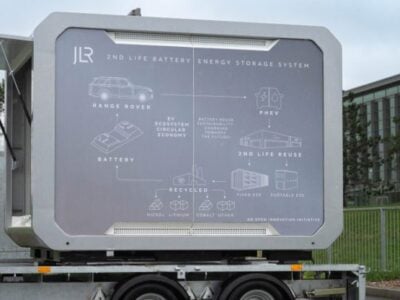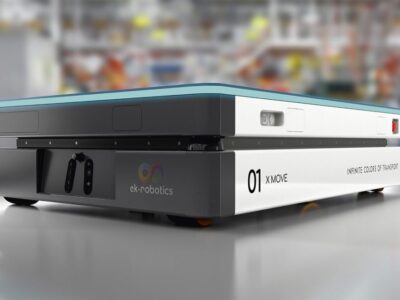
Mobileye develops single-chip supercomputer for autonomous driving
The processing of sensor information for automated driving places the highest demands on the processors entrusted with this processing and their architectures: within a very short time, the systems must process signals from different sources and with different data structures, prepare them, create a detailed situation picture and provide the basis for a safe driving decision. For this processing power, developers have put together systems-on-a-chip – complex, coordinated systems consisting of several different processors, each optimised for a specific purpose.
In this area, Mobileye has always been one of the leading technology suppliers, and while rarely does anyone in the auto industry talk about which technology suppliers they rely on, it is always clear that Mobileye, with its EyeQ family of computer chips, plays an important role in almost all major OEMs, at least in advance projects. At the CES in Las Vegas, Mobileye presented a new flagship of its EyeQs, the Ultra model. With its computing power of 176 Tera Operations per Second (TOPS), the chip is already in the top group of what is currently offered for comparable purposes. Developers consider the quotient of the consumed electrical power and the computing power to be at least as important. It gives an indication of the efficiency of these components – and it has to be high, because no carmaker wants to fit an energy guzzler under the bonnet.
According to the Mobileye, the EyeQ Ultra represents an evolutionary leap in the EyeQ SoC family and combines the performance of ten SoCs from the penultimate development stage EyeQ5 in a single chip. By using 5-nanometre process technology, EyeQ Ultra can meet all the requirements and applications of Level 4 (L4) autonomous driving, according to the manufacturer. At the same time, it avoids the energy consumption and costs associated with integrating multiple SoCs. Like its EyeQ predecessors, EyeQ Ultra has been developed with associated software from a single mould, enabling high energy efficiency without sacrificing performance.
The Ultra uses four classes of proprietary accelerators, each designed for a specific task. These accelerators are combined with additional CPU cores, ISPs and GPUs to create a highly efficient solution. This allows data from two sensor subsystems (such as a camera-only system and a combined radar and lidar system), the vehicle’s central computing system, high-resolution maps and driving policy software to be processed. This, Mobileye says, makes the EyeQ Ultra more efficient than other AV solutions and provides the necessary performance and price level required for autonomous driving for private vehicles.
The launch of EyeQ Ultra coincides with two new EyeQ SoCs for ADAS – the EyeQ6 Light and EyeQ6 High. The first chip in Mobileye’s EyeQ series was introduced in 2004 and had a lasting impact on the ADAS market. It enabled the implementation of safety technologies such as collision warning, lane departure warning or blind spot detection for millions of drivers at an affordable price.
EyeQ6 Light is the successor to the EyeQ4 SoC in a chip that is only 55 per cent the size of the EyeQ4. This “one-box” solution for use behind the windscreen delivers more deep-learning TOPS with ultra-low power consumption for highly efficient entry-level and premium driver assistance (L2) systems. Test series started last year; production is scheduled to start in mid-2023.
EyeQ6 High supports premium driver assistance systems or semi-automated driving functions with 360-degree environment detection. The computing power is equivalent to two EyeQ5 SoCs, but mainly supports visualisation and delivers better artificial intelligence performance under heavy workloads. This centralised solution will enable all ADAS-L2+ functions as well as multi-camera processing (including parking cameras) and offers integration with third-party applications such as parking visualisation and driver monitoring. Test series of the most advanced ADAS SoC in the EyeQ family will begin later this year. Production is scheduled to start by the end of 2024. The Ultra is scheduled to enter volume production at the end of 2023; production for the automotive industry is scheduled to start in 2025.
At the same time as unveiling the new EyeQ flagship, Intel / Mobileye announced a number of strategic collaborations with partners from the automotive industry. These include the use of swarm data for driver assistance systems: Volkswagen Group is the first automaker to use Mobileye’s map data to enhance the convenience and safety of driver assistance features worldwide.
Mobileye Roadbook is a crowd-based cloud database of accurate, high-resolution maps. The swarm data is aggregated from vehicles equipped with Mobileye technology around the world. VW is using this data to significantly improve the driving experience and availability of Travel Assist 2.5. For example, Travel Assist, including lane departure warning, is offered without lane markings in many areas, where available. Mobileye’s proprietary Road Experience Management technology automatically bundles and generates AV maps in the cloud, providing a global and scalable mapping solution for automated vehicles. The Roadbook-enhanced Travel Assist feature will soon be available in Volkswagen, Škoda and Seat electric vehicle (EV) models based on Volkswagen’s MEB platform.
Ford plans to deepen its long-standing collaboration with Mobileye. For example, the OEM will use Mobileye’s REM (Road Experience Management) technology in future versions of Ford BlueCruise. This technology makes it possible to implement L3 functionality with semi-autonomous driving, where the driver’s attention is captured by a camera. In doing so, Ford is using Mobileye’s REM to extend true hands-free driving on pre-qualified sections of interstate roads with separated lanes. The technology builds on Ford’s available Adaptive Cruise Control with stop-and-go and lane-centring technology.
The companies are also working together on an open Mobileye platform. This will enable Ford to develop and integrate its own solutions to make driving safer and easier in the future.
Together with Mobileye, Zeekr (the premium electric brand of Chinese OEM Geely) plans to build an all-electric vehicle based on Level 4. The Mobileye True Redundancy sensor technology, the REM mapping technology and the RSS-based driving strategy (Responsibility-Sensitive Safety) as well as the redundant braking, steering and power supply systems of the Geely SEA architecture as part of an Open EyeQ concept are components of this. The latter provides for the seamless integration of Mobileye and Zeekr technologies. It is expected to be the world’s first L4 private vehicle, initially available in China in 2024.
Video: VW CEO Herbert Diess talks to Mobileye CEO Amnon Shashua: https://www.youtube.com/watch?v=SnJXdfrybLI&t=28s
Related articles:
Automotive SoC combines 500 eTOPS with high-res image and radar processing
Intel could make automotive chips to ease shortfall, says CEO
BMW, Mobileye feed HD map data to service cloud
Mobileye tests self-driving vehicles in New York City
Nvidia announces production ready AD reference platform
Nvidia announces new superprocessor for autonomous cars
Mercedes hands-free driving available in series production
Mobileye, Schaeffler, Sixt cooperate for robotaxi service in Munich
Intel pushes the European car business
Tesla unveils custom chip for AI-training supercomputer
 If you enjoyed this article, you will like the following ones: don't miss them by subscribing to :
eeNews on Google News
If you enjoyed this article, you will like the following ones: don't miss them by subscribing to :
eeNews on Google News




